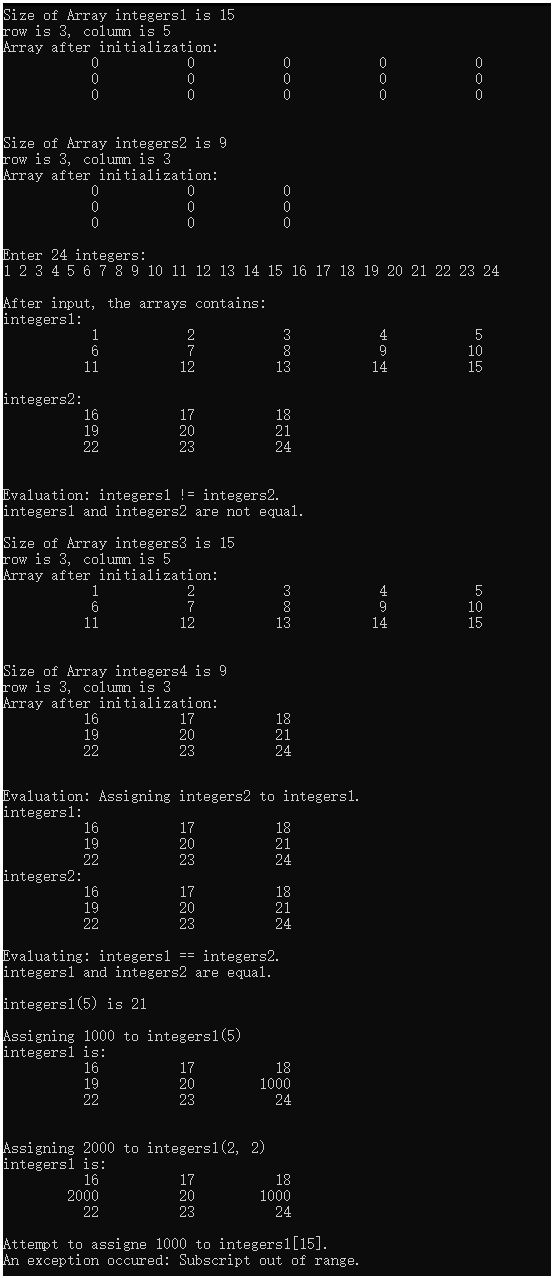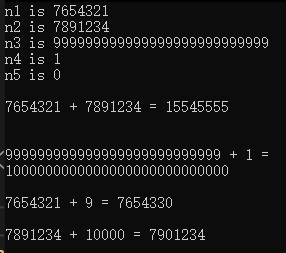一些运算符重载的例子
DoubleSubscriptedArray类:重载函数调用运算符()
类的需求:
DoubleSubscriptedArray.h
#include <iostream>
class DoubleSubscriptedArray
{
friend std::ostream& operator<<(std::ostream&, const DoubleSubscriptedArray&);
friend std::istream& operator>>(std::istream&, DoubleSubscriptedArray&);
public:
DoubleSubscriptedArray(int = 3, int = 3); // 默认构造函数,默认生成一个 3 * 5 的二维数组
DoubleSubscriptedArray(const DoubleSubscriptedArray&); // 拷贝构造函数
~DoubleSubscriptedArray(); // 析构函数
int getSize() const // 返回该二维数组中的元素个数,row * column
{
return row * column;
}
int getRow() const // 返回行数
{
return row;
}
int getColumn() const // 返回列数
{
return column;
}
// 重载的运算符函数
const DoubleSubscriptedArray& operator=(const DoubleSubscriptedArray&);
bool operator==(const DoubleSubscriptedArray&) const;
// 在类声明中直接定义重载的 != 运算符,使其成为内联函数,减少调用它的额外开销
bool operator!=(const DoubleSubscriptedArray& right) const
{
return !((*this) == right);
}
// 两种访问二维数组元素的方法
const int& operator()(int, int) const;
int& operator()(int, int);
// 因为二维数组本质上是由一个内置的一维数组实现,所以可以只使用一个参数来访问二维数组的指定元素
const int& operator()(int) const;
int& operator()(int);
private:
// 该二维数组由一个一维数组实现
size_t row;
size_t column;
int* ptr;
};
DoubleSubscriptedArray.cpp
#include <iostream>
#include <iomanip>
#include <stdexcept>
#include "DoubleSubscriptedArray.h"
using namespace std;
ostream& operator<<(ostream& output, const DoubleSubscriptedArray& array)
{
for (size_t i = 0; i < (array.getRow() * array.getColumn()); i++)
{
output << setw(12) << array.ptr[i];
if ((i + 1) % array.getColumn() == 0)
{
output << "\n";
}
}
// 如果最后一行没有满,输出结束再输出一个新行
if(array.getSize() % array.getColumn() != 0)
output << endl;
return output;
}
istream& operator>>(istream& input, DoubleSubscriptedArray& array)
{
for (size_t i = 0; i < (array.getRow() * array.getColumn()); i++)
{
input >> array.ptr[i];
}
return input;
}
DoubleSubscriptedArray::DoubleSubscriptedArray(int rows, int columns)
: row(rows > 0 ? rows :
throw out_of_range("Array row must be greater than 0.")),
column(columns > 0 ? columns :
throw out_of_range("Array column must be greater than 0.")),
ptr(new int[row * column])
{
for (size_t i = 0; i < getSize(); i++)
{
ptr[i] = 0;
}
}
DoubleSubscriptedArray::DoubleSubscriptedArray(const DoubleSubscriptedArray& array)
: row(array.row),
column(array.column),
ptr(new int[row * column])
{
for (size_t i = 0; i < getSize(); i++)
{
ptr[i] = array.ptr[i];
}
}
DoubleSubscriptedArray::~DoubleSubscriptedArray()
{
delete[] ptr;
}
const DoubleSubscriptedArray& DoubleSubscriptedArray::operator=(const DoubleSubscriptedArray& right)
{
// 避免自我赋值
if (this == &right)
{
return *this;
}
// 判断两个对象大小是否相同
if (getSize() != right.getSize())
{
delete[] ptr;
row = right.row;
column = right.column;
ptr = new int[getSize()];
}
for (size_t i = 0; i < getSize(); i++)
{
ptr[i] = right.ptr[i];
}
return *this;
}
bool DoubleSubscriptedArray::operator==(const DoubleSubscriptedArray& right) const
{
// 行或列有一个不相同则一定不同
if (row != right.getRow() || column != right.getColumn())
{
return false;
}
// 行、列都相同,接着判断每个元素是否相同
for (int i = 0; i < (row * column); i++)
{
if (ptr[i] != right.ptr[i])
{
return false;
}
}
return true;
}
const int& DoubleSubscriptedArray::operator()(int rows, int columns) const
{
// 判断参数是否越界
// 参数从1开始
if ((rows - 1) < 0 || (rows - 1) >= row)
{
throw out_of_range("row out of range.");
}
if ((columns - 1) < 0 || (columns - 1) >= column)
{
throw out_of_range("column out of range.");
}
return ptr[(rows - 1) * columns + (columns - 1)];
}
int& DoubleSubscriptedArray::operator()(int rows, int columns)
{
// 判断参数是否越界
// 参数从1开始
if ((rows - 1) < 0 || (rows - 1) >= row)
{
throw out_of_range("row out of range.");
}
if ((columns - 1) < 0 || (columns - 1) >= column)
{
throw out_of_range("column out of range.");
}
return ptr[(rows - 1) * columns + (columns - 1)];
}
const int& DoubleSubscriptedArray::operator()(int n) const
{
// 判断参数是否越界
// 参数从1开始
if (n < 0 || n >= getSize())
{
throw out_of_range("Subscript out of range.");
}
return ptr[n];
}
int& DoubleSubscriptedArray::operator()(int n)
{
// 判断参数是否越界
// 参数从1开始
if (n < 0 || n >= getSize())
{
throw out_of_range("Subscript out of range.");
}
return ptr[n];
}
test.cpp
#include <iostream>
#include <stdexcept>
#include "DoubleSubscriptedArray.h"
using namespace std;
int main()
{
DoubleSubscriptedArray integers1(3, 5);
DoubleSubscriptedArray integers2;
cout << "Size of Array integers1 is " << integers1.getSize()
<< "\nrow is " << integers1.getRow() << ", column is " << integers1.getColumn()
<< "\nArray after initialization:\n" << integers1 << endl;
cout << "\nSize of Array integers2 is " << integers2.getSize()
<< "\nrow is " << integers2.getRow() << ", column is " << integers2.getColumn()
<< "\nArray after initialization:\n" << integers2 << endl;
cout << "Enter 24 integers: " << endl;
cin >> integers1 >> integers2;
cout << "\nAfter input, the arrays contains:\n"
<< "integers1:\n" << integers1
<< "\nintegers2:\n" << integers2 << endl;
cout << "\nEvaluation: integers1 != integers2." << endl;
if (integers1 != integers2)
{
cout << "integers1 and integers2 are not equal." << endl;
}
// 调用拷贝构造函数,创建两个新对象
DoubleSubscriptedArray integers3(integers1);
DoubleSubscriptedArray integers4 = integers2; // 隐式调用拷贝构造函数,并不是使用重载的赋值运算符
cout << "\nSize of Array integers3 is " << integers3.getSize()
<< "\nrow is " << integers3.getRow() << ", column is " << integers3.getColumn()
<< "\nArray after initialization:\n" << integers3 << endl;
cout << "\nSize of Array integers4 is " << integers4.getSize()
<< "\nrow is " << integers4.getRow() << ", column is " << integers4.getColumn()
<< "\nArray after initialization:\n" << integers4 << endl;
cout << "\nEvaluation: Assigning integers2 to integers1." << endl;
integers1 = integers2;
cout << "integers1:\n" << integers1
<< "integers2:\n" << integers2 << endl;
cout << "Evaluating: integers1 == integers2." << endl;
if (integers1 == integers2)
{
cout << "integers1 and integers2 are equal." << endl;
}
// 测试重载的 () 运算符
cout << "\nintegers1(5) is " << integers1(5) << endl;
cout << "\nAssigning 1000 to integers1(5)" << endl;
integers1(5) = 1000;
cout << "integers1 is:\n" << integers1 << endl;
cout << "\nAssigning 2000 to integers1(2, 2)" << endl; // 下标为5的元素处于第二行第二列
integers1(2, 2) = 2000;
cout << "integers1 is:\n" << integers1 << endl;
// 测试该类的对象是否会自动检查边界
try
{
cout << "Attempt to assigne 1000 to integers1[15]." << endl;
integers1(15) = 1000;
}
catch (out_of_range& e)
{
cout << "An exception occured: " << e.what() << endl;
}
}
运行结果:

上面代码中并没有重载双方括号运算符,因为它需要创建一个辅助类(管理单行,将一行看成一个一维数组来管理),在该辅助类中重载一个[]运算符,再在二维数组类中重载一个[]运算符,让它访问一行。由链式使用两个[]运算符来实现二维数组的访问,感兴趣的同学可以自己试着实现一下。
HugeInt类:大整数类
HugeInt.h
#include <iostream>
#include <array>
#include <string>
class HugeInt
{
friend std::ostream& operator<<(std::ostream&, const HugeInt&);
public:
static const int digits = 30; // HugeInt类对象的最大长度
HugeInt(long = 0); // 默认构造函数,同时也是一个转换构造函数(long->HugeInt)
HugeInt(const std::string&); // 转换构造函数,从string类对象转换成HugeInt
// 重载加法运算符
// 实现 HugeInt + HugeInt
HugeInt operator+(const HugeInt&) const;
// 实现 HugeInt + HugeInt
HugeInt operator+(const int) const;
// 实现 HugeInt + HugeInt
HugeInt operator+(const std::string&) const;
private:
std::array <short, digits> integer;
};
HugeInt.cpp
#include <cctype>
#include "HugeInt.h"
using namespace std;
ostream& operator<<(ostream& output, const HugeInt& num)
{
int i = 0;
// 跳过数组前面的0,最低位放在数组的最后一位
for(i = 0; (i < HugeInt::digits) && (num.integer[i] == 0); i++)
;
// 如果此时i指向已经是数组的结尾
if(i == HugeInt::digits)
output << 0; // 此时该HugeInt对象的值为0
else
{
for(; i < HugeInt::digits; i++)
output << num.integer[i];
}
return output;
}
HugeInt::HugeInt(long value)
{
// 将数组内容初始化为全0
// 必须使用引用,才能修改数据成员array对象的值
for(short& element : integer)
element = 0;
// 获取一个整型类型的数值的最低位是最方便的,%10和/10
for (size_t i = digits - 1; value != 0 && i >= 0; i--)
{
integer[i] = value % 10;
value /= 10;
}
}
HugeInt::HugeInt(const string& number)
{
for (short& element : integer)
element = 0;
// HugeInt对象的长度
size_t length = number.size();
// 获取一个string对象的第一个字符是最容易的
for (size_t i = digits - length, j = 0; i < digits; i++, j++)
{
integer[i] = number.at(j) - '0'; // array对象中元素的类型为short,而字符在内存中保存的是ASCII编码的码值
// 所以需要将其转换成对应的整型数值
}
}
HugeInt HugeInt::operator+(const HugeInt& right) const
{
HugeInt temp; // 保存计算结果
int carry = 0; // 进位数
// 从最低位开始计算
for (int i = digits - 1; i >= 0; i--)
{
temp.integer[i] = integer[i] + right.integer[i] + carry;
if (temp.integer[i] > 9)
{
temp.integer[i] %= 10;
carry = 1;
}
else
{
carry = 0;
}
}
return temp;
}
HugeInt HugeInt::operator+(int right) const
{
return (*this) + HugeInt(right); // 使用转换构造函数将参数right转换成HugeInt类型对象
// 再使用两个HugeInt对象的加法运算符进行计算
}
HugeInt HugeInt::operator+(const string& right) const
{
// 同样使用转换构造函数将string对象转换成HugeInt对象,再进行计算
return (*this) + HugeInt(right);
}
test.cpp
#include <iostream>
#include "HugeInt.h"
using namespace std;
int main()
{
HugeInt n1(7654321); // 转换构造函数
HugeInt n2(7891234); // 转换构造函数 long->HugeInt
HugeInt n3("999999999999999999999999999"); // string->HugeInt
HugeInt n4("1"); // string->HugeInt
HugeInt n5; // 默认构造函数
cout << "n1 is " << n1 << "\nn2 is " << n2
<< "\nn3 is " << n3 << "\nn4 is " << n4
<< "\nn5 is " << n5 << endl;
n5 = n1 + n2; // HugeInt + HugeInt
cout << "\n" << n1 << " + " << n2 << " = " << n5 << "\n\n";
n5 = n3 + n4; // HugeInt + HugeInt
cout << "\n" << n3 << " + " << n4 << " = \n" << n5 << "\n\n";
n5 = n1 + 9; // HugeInt + int
cout << n1 << " + " << 9 << " = " << n5 << "\n\n";
n5 = n2 + "10000"; // HugeInt + string
cout << n2 << " + " << "10000" << " = " << n5 << endl;
}
运行结果:

上面代码中只定义了HugeInt类中的加法操作,大家还可以参照上面的形式,补充其他运算。






















 587
587

 被折叠的 条评论
为什么被折叠?
被折叠的 条评论
为什么被折叠?








